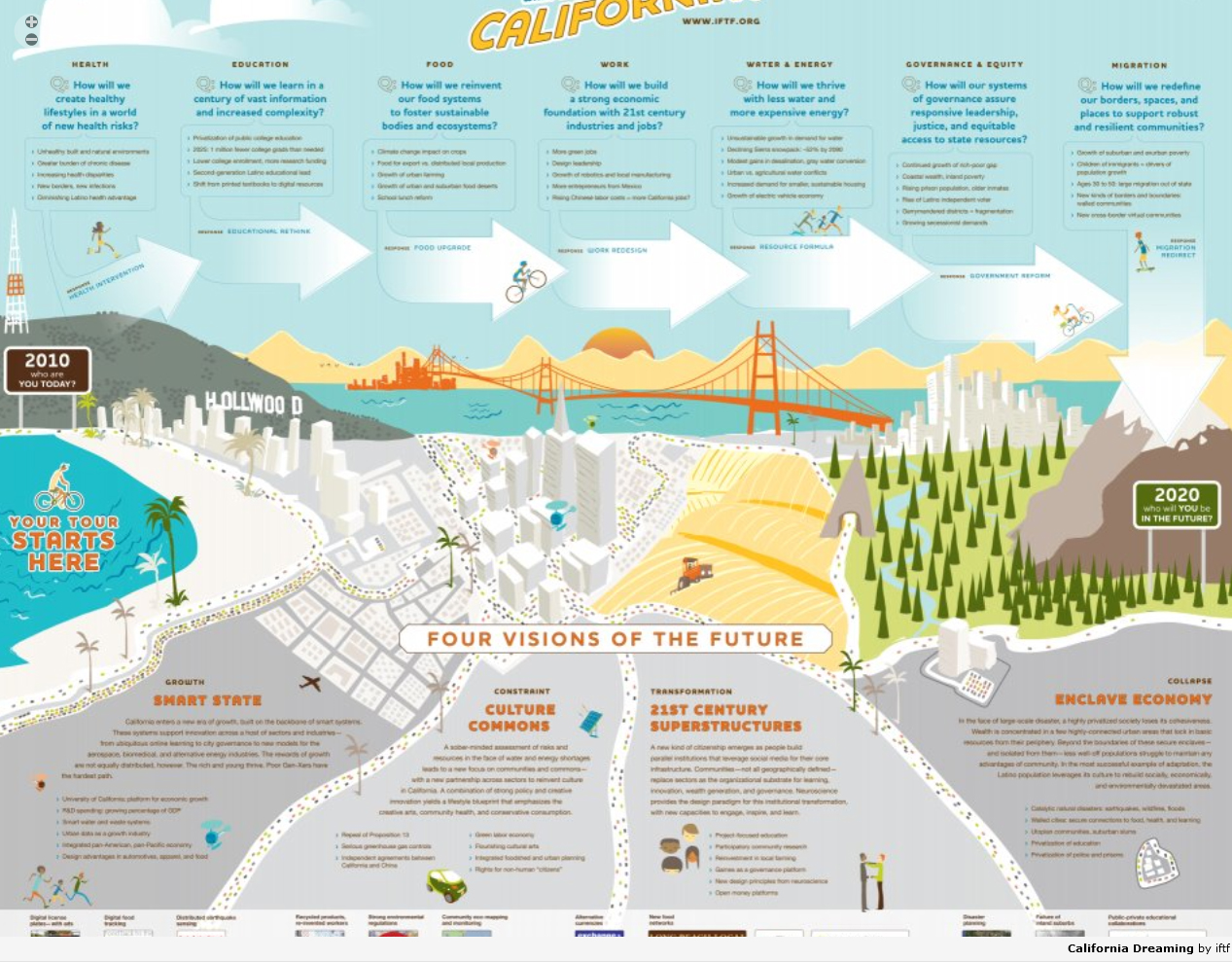Looking Ahead at California Beyond the Crisis
New Forecast Map Provokes Public to Get Engaged with the Future of the State
Palo Alto and San Diego, CA, Sept. 28, 2010 -- What is possible when everyday citizens are inspired to imagine a new future for California?
|
The interactive map, available at California Dreaming: Imaging New Futures for the State, illustrates the findings including four alternative visions for California. The map resulted from a workshop with multi-disciplinary experts and is being published in collaboration with California Institute of Telecommunications and Information Technology (Calit2) and the Center for Information Technology Research in the Interest of Society (CITRIS).
The four alternative scenarios of how the future might unfold span across a world of growth or collapse, constraint or transformation. The map also explores seven big questions facing California in the areas of health, education, food, work, water/energy, governance/equity and migration.
Designed as a process to provoke insight, the map provides a workspace for individuals working alone, with their institutions, or in their broader communities to systematically consider their role in the issues today and how they would like to impact the future in 2020.
“California is in crisis. Our school system is on the verge of collapse, our natural resources are strained, we do not have enough water to sustain our farmland heritage, our health care safety net continues to unravel and our elected officials are struggling to pick up the pieces,” said Marina Gorbis, IFTF Executive Director. “We felt it was critical for IFTF to play a role in helping address this crisis. By harnessing our expertise in spotting emerging trends and discontinuities and tapping our network of experts, we’ve created a map that we hope will inspire and empower California residents to shape a better future for their state.”
IFTF also has plans to conduct workshops to facilitate this thinking and hopes to reframe the public policy discussion.
“The best way to influence the politicians is to educate and stimulate the thinking of the electorate,” said Larry Smarr, director of the California Institute for Telecommunications and Information Technology (Calit2). California, Smarr said, has “locked itself into a very 20th-Century way of looking at things, and this kind of exercise can help reframe the discussion.”
Some of the driving influences uncovered by the research include many local examples of ordinary citizens who are superstructing abundance, i.e., building on an abundance of existing resources and taking them to new scales. The research also looks at civic engagement as a signal that citizens are gathering within the context of existing organizations to reinvent systems. Case in point: the “smart-state” efforts at UC San Diego’s Sustainability 2.0 initiative. Another trend is how California is gaming its way toward solving real-world problems using social media platforms and games to collaborate in governance, solving resource problems, setting policy, and enforcing decisions.
For more information and a copy of the map, please visit http://www.iftf.org/futureofcalifornia or contact Anna Davies at adavies@iftf.org.
About the Institute for the Future
The Institute for the Future (IFTF) is an independent, nonprofit research group with 42 years of forecasting experience. IFTF’s core work is in identifying emerging trends and discontinuities that will transform global society and the global marketplace. IFTF provides insights into business strategy, design process, innovation, and social dilemmas with research that generates the foresight needed to create insights that lead to action. IFTF research spans a broad territory of deeply transformative trends, from health and health care to technology, the workplace, and human identity. The Institute for the Future is located in Palo Alto, Calif. www.iftf.org
About Calit2
The California Institute for Telecommunications and Information Technology (Calit2) unites faculty, students and research professionals at the University of California, San Diego and the University of California, Irvine with private-sector partners to explore how emerging information technologies and telecommunications can transform areas vital to the state’s economy and our citizens’ quality of life. The institute explores the enabling technologies of wireless communications, photonics, nanotechnology and micro-electro-mechanical systems, as well as cyberinfrastructure, and applies those technologies to four areas that are being transformed in the digital age: health, energy, the environment and culture. Calit2 celebrate its 10th anniversary in December 2010. www.calit2.net
About CITRIS
The Center for Information Technology Research in the Interest of Society — CITRIS — creates information technology solutions for many of our most pressing social, environmental, and health care problems. CITRIS, a partnership of the UC campuses at Berkeley, Davis, Merced and Santa Cruz, was created to “shorten the pipeline” between world-class laboratory research and the creation of start-ups, larger companies, and whole industries. www.citris-uc.org/
Related Links
IFTF
California Dreaming: Imaging New Futures for the State
Media Contacts
IFTF: Jean Hagan, 650-233-9551, jhagan@iftf.org; Calit2: Doug Ramsey, 858-822-5825, dramsey@ucsd.edu; CITRIS: Tracy Allen, 510-643-9034, citris-admin@citris-uc.org

